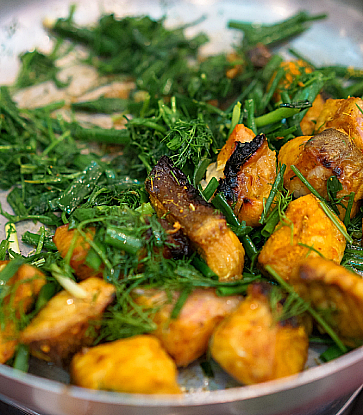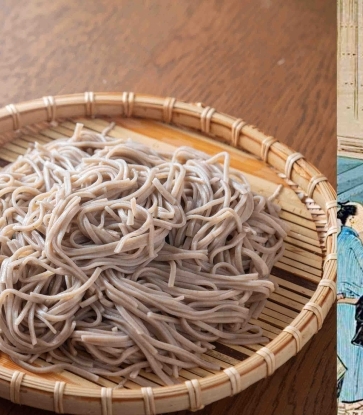Then comes the food: Fresh-off-the-grill kinmedai (golden eye snapper) on a bed of oka-hijiki seaweed and grated karasumi, the buttery block of well-marbled omi wagyu that is glazed with a boldly tart aged akazu vinegar dressing. To wash the food down, teas are served in white wine and martini glasses.
Esora’s chef-owner Shigeru Koizumi steers away from the rigid norms of Japanese fine-dining restaurants. Quite the mild-mannered maverick, the 34-year-old Tochigi native says: “I like to offer a fresh and playful perspective on Japanese culture, where I can merge my respect for nature with modern cooking techniques into my cuisine.”
He adds that this also helps Esora to stand out from the sea of restaurants serving Kappo-style cuisine, which means “to cut and to cook”. Dishes are served over several courses that are decided by the chef.

Take his cooking treatment of kinmedai: he oil-bastes the dish at precisely 62 degree Celcius before finishing it off on a charcoal grill to retain the juiciness of the fat-laden meat. He also uses pacojets and liquid nitrogen to make desserts like strawberry cream sorbet, ice cream powder and espuma.
Besides the food, service is also more intimate with only nine seats at the chef’s counter and a handful of dining tables. The service staff or Koizumi himself attentively dish out nuggets of information, such as the provenance of the ingredients and the cooking techniques.
“In Japanese restaurants here, the chef's interaction with diners is limited to those who sit by the counter and they hardly go to the private dining rooms,” he says. “It is important to foster a closer relationship with them so I can share stories about the food to diners. I really want to talk to them.”
However, he doesn’t eschew tradition completely. The seven- or nine-course menu still includes a sashimi course and concludes with a donabe claypot course, as in a Kappo-style meal.

How does Koizumi marry modernity with tradition in his cuisine? He says that having a solid grasp on traditional boundaries of Japanese food helps to push the envelope in an organic way.
“While trying to offer my own interpretation of the cuisine, a challenge for me is to always ensure that I respect traditions even when I’m doing things slightly differently,” he explains.
Like most Japanese chefs, who have a knack for precision, Koizumi adopts a “one degree” approach to cooking. Each dish is treated with reverence, in which the slightest change in temperature can affect the flavours. For example, the omi beef (left) is cooked in an oil bath at 62 degree Celcius before hitting the grill to yield a melt-in-your-mouth texture
Japanese To French Kitchen Transition
Incorporating modern cooking into Japanese cuisine isn’t exactly new ground for Koizumi. He did a five-year stint at the three-Michelin-starred Nihonryori RyuGin in Tokyo, which has gained worldwide acclaim for its sublime modern Japanese cuisine.
Recalling his cooking stint there, he says: “Under head chef Seiji Yamamoto, I learnt to how to be in tune with my creative side and project my imagination onto a plate. I also got acquainted with the modern cooking tools that I use at Esora.”
He adds: “I was also exposed to a diverse range of cultures and cooking techniques as the kitchen staff are from around the world.”

After cooking in Japan for years, the urge to broaden his culinary horizons grew stronger and he started eyeing cooking opportunities abroad. Singapore was top on his list as he was attracted by its status as a dining hub, where there is “access to the best ingredients around the world”.
He explains that while Japan has a rich bounty of home-grown produce, chefs there are often reluctant to use imported ingredients. “I wanted to be more flexible in using and learning more ingredients, techniques and cultures,” he adds.
Koizumi has a long history of using home-grown produce. Growing up in the countryside area of Nasu, he grilled freshly-caught fishes from the river and plucked wild spring vegetables along the streets for his mother to cook tempura dishes at home.
While in high school, his interest in cooking grew through working as a waiter and chef assistant. He later attended culinary school in Tochigi before cutting his teeth at Japanese restaurants in Tokyo for five years. Then, the opportunity to work in Nihonryori RyuGin came.

He relished the possibilities of using ingredients and presenting them in varying forms that working in Odette offered.
Take cooking beetroot for example. “Japanese cuisine tends to be very straightforward. The ingredients are simply cooked before being served to the customers,” he explains. “But, in Odette’s Beetroot Garden, the root vegetable is grilled, presented in a powder and ice-cream.”

He is optimistic that diners here can embrace modern Kappo cuisine, even though it goes beyond the typical expectations of a Japanese restaurant.
He notes: “I’ve observed that most diners here are receptive when it comes to exploring the different types and styles of Japanese cuisine. They appreciate refreshing concepts that offer inspired perspectives.”






















